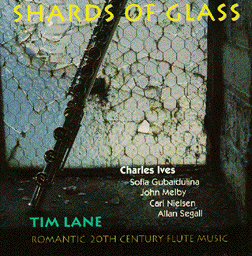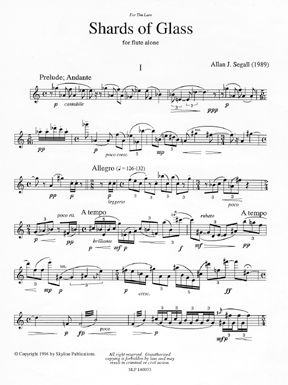Shards of Glass
for flute solo
by Allan J. Segall
Unlike many of the flute solos written during this Century, Shards of Glass does not aim at breaking new ground. Avoided are the types of extended coloristic techniques (such as multiphonics and key clicks) that have largely typecast this genre as a vehicle of the avant-garde. Shards of Glass focuses more on issues of melodic invention than exotic color.
Written in 1989 for Tim Lane, Shards' descriptive title was conceived as a metaphor that mirror's the work's fragmented arabesque-like nature. But unlike Gubaidulina's Sounds of the Forest, Shards of Glass - which might convey a condensed multi-movement 19th century Sonata - remains a thoroughly abstract work; its fast outer movements, which contain fragments of lyrical motifs tightly strung together, bookend a weightier, more slowly unfolding central Adagio.
If Shards sounds "romantic", it is probably due in part to its tonal language. Perhaps the most overtly romantic movement, the bravura finale (fancifully described by one listener as a klezmer band run amok) suggests a type of orientalism peculiar to late-romantic Russian music.
Shards of Glass received its first performance by Tim Lane in 1991 at the University of Wisconsin-Eau Claire, and has been widely performed throughout the United States and Europe.
- from liner notes to Shards of Glass, a CD produced by Zuma Records Inc., 275 Central Park West, New York, NY 10024 USA.
Shards of Glass is a First Prize winning composition in the 1996 National Flute Association Competition for Newly Published Flute Music.

This CD, ZMA 104, features Tim Lane performing several 20th century works for the flute, including Shards of Glass.

Select the headphone image above to hear the very beginning of Shards of Glass
Select Current Catalog for latest price.
Two reviews from The British Flute Society's magazine "Pan":
Allan J. Segall Shards of Glass Skyline Publications
Any flute player trying out the first few bars of this piece will find it hard not to continue. Here is a contemporary piece written in a more than approachable style: it is atmospheric, rhythmically complex and positively seductive, with flute-breaking contemporary techniques kept to a minimum.
In the first movement, it establishes its credentials immediately with the sort of melody that we love to play - wide yearning intervals in the bottom register drawing the player and listener ever onwards into greater intensity, and ending with the kind of flourish that will invite premature applause from any audience.
The second movement is at once more intimate sounding, more extensive and more penetrating, while retaining the same abstract yet romantic style of the opening. The last movement opens with a brisk and driving figure which does not relax for a second, running headlong into the ending which is, outrageously, placed firmly in the key of C major.
The print is on the small side, but very clear, and the music is laid out with the performer in mind, with convenient open-out pages. I can enthusiastically recommend this challenging but very rewarding music to anyone looking for a substantial new solo piece for their repertoire.
Leslie Sheills
Shards of C/ass, Romantic 20th Century Flute Music Tim Lane flute
Barbara Wimunc-Pearson piano Zuma Records ZMA 104
Tim Lane was a new name to me, and he proves to be a very accomplished flautist. He his played with many orchestras in America including the Cleveland, and is a Professor at the University of Wisconsin The disc opens with what I considered to he the most interesting track on it Sofia Gubaidulina's Sounds of the Forest, a Prokofievesque scherzo which deserves to be much better known. The unaccompanied Shards of Glass, which gives the CD its title, was written for Tim Lane in 1989 by Allan J. Segall. Deliberately avoiding avant-garde techniques, Shards of Glass is described as "a tonal work conveying a multi-movement 19th century sonata" It is very well played but I found that its ten minute length is not really sustained in terms of musical effectiveness, especially the closing section, which sounds like a pastiche of a virtuoso study (which may perhaps have been the composer's intention). Charles lves' Third Sonata (originally for violin and piano) is typically quirky but, at very nearly thirty minutes duration; too long for this listener as much of the writing does not really suit transcription to flute. This work does however contain some very impressive piano playing.
John Melby's Concerto for Flute and Synthesized Sounds (1990) is an interesting work; written in twelve-tone language but with almost romantic contrapuntal textures. The flute playing is terrific, although occasionally the computer-generated synthesized accompaniment reminded me of a Dr. Who soundtrack. The only two pieces on the CD likely to be familiar to most flautists are Nielsen's The Fog is Lifting and The Children are Playing - the simplicity of both being very refreshing to the ear at the end of this collection.
To sum up: a mixed bag in terms of musical content but everything is very well played. Nearly all the tracks were recorded in live recitals and there is a nice concert hall ambience to the sound.
Kenneth Bell